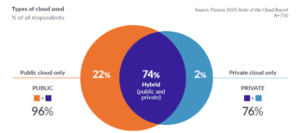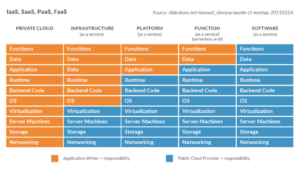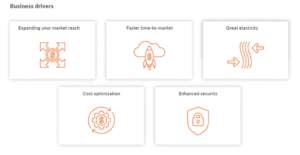Cloud Migration services in USA business organizations today consider cloud computing a crucial element of their IT strategies. The necessity of companies that wish to keep up with market trends, customers’ shifting expectations in an ever-changing world, and innovation is no longer a choice; it is a must.
The use of cloud-based Cloud Migration services in USA AI in 2020-2021 has only hastened with its widespread acceptance, especially since the global COVID-19 pandemic has hit us all. Businesses are bringing their cloud transformation game up with projects that may also handle remotely. Many firms are seeking to become more agile and gain a competitive advantage by using digital transformation.
According to a cloud migration case study conducted recently by MariaDB, 40% of IT leaders believe that COVID-19 is helping them make the transition to the cloud. Migrating to the cloud is now one of the most important ways to remain relevant and enjoy a leading edge. Even while cloud use has risen overall, businesses frequently struggle with cloud transformation, making it difficult and counterproductive from the beginning. Many firms fail to utilize the cloud’s advantages fully. Thus, it is imperative first to understand the strategy behind ‘clouding data’ and associated cloud migration benefits that lead to digital transformation.
Types of Cloud Computing Services:
Cloud Migration services in USA almost all businesses (around 90%) use cloud computing types in some manner. Public, private, and hybrid clouds are deployment models from which firms can select. Most providers will use IaaS, SaaS, PaaS, or FaaS.

What are Cloud Computing Services?
Migrating business activities into the cloud is an effective cloud computing service known as cloud migration. The vast majority of the time, “cloud migration” refers to the transition from legacy infrastructure (on-premises or off-premises) to the cloud. In order to construct and sustain an on-site infrastructure, companies prefer to shift their data to the cloud for more accessible storage, backup, and recovery. Any company is not only able to streamline business procedures that are critical to the success of digital transformation. But, it also essentially adds to lower costs, powerful system security, and improved execution of business operations. Various types of cloud computing exist to suit the diverse needs of enterprises. Let’s have a look at them.
Infrastructure as a Service (IaaS)
Infrastructure as a Service (IaaS) in cloud computing gives you access to primary computational resources, both physical and virtual, including software for OS, space for data center, and networking infrastructure. IaaS in cloud computing empowers the development of a remote cloud data center within an IT infrastructure instead of constructing an on-site data center.
AWS (Amazon Web Service), Microsoft Azure, GCP, and Cisco Meta cloud, are all IaaS examples.
Platform as a Cloud Migration services in USA (PaaS)
A fully controlled and functional cloud-based platform for designing, running, and administering applications is provided by Platform as a Service (PaaS). The company’s resources — including servers, networking, memory storage, and OS software — are hosted in the PaaS provider’s data center. The team’s only responsibility is to ensure that data, apps, and functionality are deployed in the cloud. The benefit of PaaS is that you can deploy apps faster than usual because the company’s IT team has to focus on software development without stressing over the underlying infrastructure.
Popularly used PaaS platforms are Google App Engine, Apache Stratos, and (AWS) Amazon Web Service Elastic Beanstalk.
Software as a Cloud Migration services in USA(SaaS)
SaaS software is fully developed software that may be accessed through the web or by desktop clients. Typically, vendor APIs are available on a monthly or annual subscription. As a result, SaaS (Software as a Service) is the most commonplace kind of cloud computing. SaaS. Since everything, including (virtualization, storage, servers, runtime, application, middleware, Operating System software, and cloud networking, is managed by a vendor, SaaS applications are prevalent. Data alone belongs to the client.
(SaaS) includes MS Office 365, Google Applications, Cisco, Salesforce, and WebEx.
Function as a Service(FaaS)
Function as a Service is the most advanced form of cloud-based service that allows serverless operations to enable businesses to design, execute, and manage features of an application without worrying about the infrastructure complexities that come with developing and deploying an app.
IBM Cloud Functions, Google Cloud Functions, AWS Lambda, and Microsoft Azure Functions are all examples of FaaS.

Many businesses have already switched from on-premises servers to the public cloud. Or, at the very least, a portion of their business structure has been shifted to the cloud. As per Gartner, the international market of public cloud services is estimated to secure a mark of $354.6 billion by the year 2022, rising from $227.8 billion in 2019. According to the IDC analysis, SaaS is set to overtake traditional IT spending on the public cloud during the next three years. Infrastructure as a Service (IaaS) is also described as the 2nd massive spending category. It predicts to expand the quickest over the next five years, with a predicted four-year CAGR of 32.0%. PaaS has the lowest cost-per-user (CPU) over the course of four years, with a four CAGR of 29.9%.
Strategizing Cloud Computing for Driving Business:
Defining your vision and short- and long-term goals is the first stage in the process of cloud migration. After that, you can begin planning, implementing, and administering your project. It’s crucial to think about your cloud strategy concerning your corporate strategy, or else your business might suffer risks. Understanding the drivers for business expansion using cloud migration is essential. Many executives have always embraced the cloud as a technique to save IT expenditures rather than develop brand new technological capabilities. For instance, operating expensive and time-consuming legacy systems, the implementation of cloud-based versions of corporate programs like customer relationship management (CRM) software and enterprise resource planning (ERP) (a process known as ‘lift and shift’) has emerged as one of executive’s favorite cloud solution.
Of course, this can help save money. However, it overlooks a more significant advantage of moving to the cloud: the ability to revolutionize a company’s operations digitally. Management should understand beyond short-term cost-cutting when choosing the best cloud migration path. They must concentrate on transformational goals, including adopting innovative business models, the transformation of IT department, creating compelling new digital user experiences, and improving connections with business associates. Only an organization’s creativity limits the cloud’s potential. With such objectives in mind, corporate executives should steer their cloud-based digital revolutions.

Cloud migration strategy steps
It isn’t easy to move systems from on-site PCs to public or hybrid clouds. It necessitates extensive technological capabilities. Popular computing standards, such as cloud programming interfaces for applications, must also adopted by businesses. Businesses that do not yet have a defined cloud migration strategy will almost certainly do so by 2022. According to estimations by Gartner, 70% of businesses would have developed a cloud strategy by then. So, if you don’t want to fall behind your competition, begin planning your cloud strategy today. Preferably, businesses should analyze the project with a platform. It can assist them in determining the best cloud strategy for migration. Amazon’s 6 Rs strategy works best in this case. It entails the following steps:
Rehosting:
It’s a good option if you want to quickly migrate to the cloud and with little to no changes. This method usually known as “Lift-and-Shift.”
If organizations are impotent to maintain database instances, Re-platforming, unlike Rehosting, necessitates a few changes to gain cloud computing benefits, such as transferring relational database services. Nonetheless, the underlying architecture is genuine, i.e., it remains unchanged.
Repurchasing:
This strategy entails buying new services and products. The purpose is to make a few modifications to the basic IT architecture. This method can only use if you already have a cloud environment and wish to migrate large workloads.
Refactoring:
If your company wishes to increase agility while still meeting business needs, refactoring is a perfect fit. It’s, however, a more expensive approach than other cloud migration strategies because it necessitates re-architecting the existing system.
Retire:
To use this method, you must first identify the IT assets that are no longer vital. These assets can be switched off without disrupting the transfer process.
Retain:
It combines with other techniques to come up with the best option. Once you have identified previously regarded IT resources that needs to maintain, this technique can improve profitability.
Cloud Computing Benefits:
To fully reap benefits from cloud migration in terms of business profitability, scalability, and enhanced customer experience, comprehending cloud computing definition is just the tip of the iceberg.
-
Scalability
Cloud storage makes it easier to scale your enterprise, enabling extension of support to manage larger workloads. Moreover, it accommodates a more significant number of possible users than on-site infrastructure, which necessitates typically the purchase of different physical servers, computer hardware, or software licensing. Since one is not supposed to pay for resources unused, the “pay-as-you-go” cloud computing approach is very popular among executives looking forward to digital economic transformation
2.Computation Based on demand
Cloud processing allows you to access resources required for digitalization on-demand without purchasing expensive hardware or software. It will make it easier for you to optimize network infrastructure hardware needs based on business needs.
3.Enhanced Customer Journey
One of the most beneficial cloud computing advantages for business stakeholders is to increase revenue. It generates as a result of digital transformation that significantly helps boost customer happiness.
4. Assisted Decision Making
Having access to well-organized data at any point in time allows companies to make well-informed decisions while achieving their business objectives. For businesses, digital transformation means having appropriate control in terms of entire corporate activities, which cloud computing ensures. Task delays, data loss, and inefficient management systems are all critical corporate concerns. Regarding sensitive information, “cloud innovation” gives clients a birds-eye perspective of their information, providing features like tracking and altering availability, simplicity of use, and flexibility. By offering employees individual access, cloud computing further lends a helping hand to streamline management control and workflow.
5. Operational Efficiency and Versatility
Digital Transformation of cloud computing companies smooths out operations and speeds them up. It results in a more successful firm. Users may access the cloud computing services and data they require at any time and from any location. It also aids in international expansion.
6. Better Market Infiltration
As a result of improved efficiency and decision-making brought on by digitalization and streaming of market penetration, businesses become more competitive. It aids in the development of a large consumer base and profit margins.
7. No Additional Capital Investment
By outsourcing your business needs to cloud computing service providers, organizations save money on employing more IT professionals to operate their servers.
8. Encourage Employee Coordination
Cloud migration enables your company to operate in dispersed occupational settings and gives your staff the option to work remotely. Cloud-based collaboration and communication technologies will make it much easier for them to communicate with one another. Remote access enables quick turnaround times, immediate resolution of issues, and constant collaboration, that count primarily as digital transformation aims. Professionals, individual entrepreneurs, and businesses with offices in multiple locations can benefit from organizational mobility.
9. Guarantee Data Integrity, Sustainability and Security
Cloud service providers offer significantly better resilience because they have many data center locations. They typically duplicate data which serves as a less expensive approach to take advantage of cloud economies. Cloud computing security is a significant feature. It offered to ensure confidential and private information keep hidden and save from hackers and malicious attacks. Solutions like AWS, Google Cloud, and Azure Migrate are the most reliable cloud providers. Cloud usage lessens wastage of paper, ink, and electrical consumption. Moreover, it significantly contributing to reduced carbon footprint with its omnipresent nature.
Please visit for more information…









